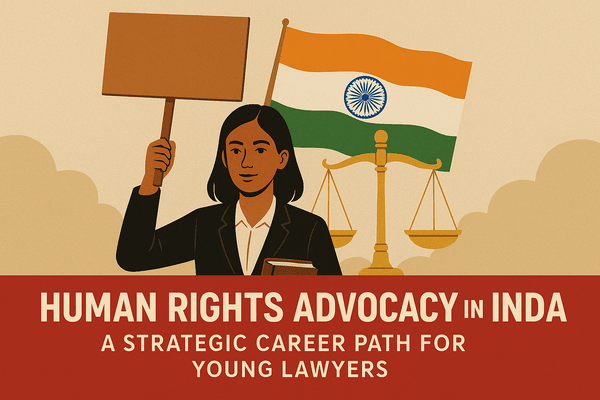In a world where justice often feels delayed, human rights law in India offers a path that is both swift and socially impactful. From custodial deaths to environmental degradation, the National Human Rights Commission (NHRC) has time and again demonstrated its ability to bring relief to victims without prolonged court proceedings. For young lawyers, especially those from non-metro areas, this is more than just an area of law—it is a platform to gain visibility, sharpen advocacy, and build a meaningful career.
Why Human Rights Law Matters More Than Ever
Human rights law protects the core of human dignity—liberty, equality, and protection from abuse of power. In India, rights enshrined in Articles 12 to 35 of the Constitution form the backbone of our democratic structure. The NHRC, State Human Rights Commissions, Women’s Commissions, and National Green Tribunal (NGT) are quasi-judicial bodies that offer faster, low-cost, and often paperless redressal of grievances.
Landmark NHRC Cases Resolved Without Court Intervention
Here are some notable cases where the NHRC intervened efficiently and brought relief—without formal litigation:
Case 1: Custodial Death in Bihar (NHRC Case No. 118/4/10/2011-AD)
A 30-year-old man, Rajesh Kumar, died in police custody under suspicious circumstances. NHRC took suo motu cognizance, investigated the postmortem and police records, and recommended ₹5 lakh compensation to the family. The Bihar government complied within 3 months.
Impact: Strengthened protocols on custodial safety and prompted police stations to install CCTV cameras.
Case 2: Bonded Labour Rescue in Tamil Nadu (NHRC Case No. 7383/22/15/2013)
NHRC received a complaint from an NGO about 28 bonded laborers in a brick kiln. The Commission immediately directed the District Magistrate to investigate. Within weeks, the victims were rescued, provided release certificates, and compensated under the Bonded Labour Act.
Impact: Empowered local administration to act decisively; showed the power of NHRC directives outside courtrooms.
Case 3: Sexual Harassment by School Principal, Odisha
In a sensitive case where a minor girl accused her school principal of harassment, NHRC expedited inquiry and recommended suspension, counseling, and state-level circulars for school protection guidelines. The Odisha State Commission followed through without needing court orders.
Impact: Fast response and systemic reform through school policy updates.
Case 4: Manual Scavenging Death in Delhi (NHRC Case No. 3034/30/0/2015)
Following the death of a sanitation worker due to hazardous conditions in a sewer, NHRC directed the municipal body to provide ₹10 lakh compensation and permanent employment to the dependent family member.
Impact: Boosted national attention on manual scavenging and led to local-level safety audits.
Ideal Combinations with Human Rights Advocacy
If you’re serious about human rights practice, combining it with complementary legal disciplines can amplify your impact and career reach:
1. Media & Human Rights Law
-
Media plays a huge role in exposing rights violations.
-
Lawyers who understand media law can ensure ethical journalism, fight fake news, and defend freedom of speech.
-
Filing PILs or complaints in media-targeted censorship issues is powerful advocacy.
Example: Defending a journalist under Article 19(1)(a) using both media & human rights law.
2. Cyber Law & Human Rights
-
In the age of surveillance, data breaches, and online harassment, digital rights = human rights.
-
Advocates in this space deal with privacy laws, women’s safety online, cyberbullying, etc.
Example: Filing NHRC complaints in cases of AI-based discrimination or cyber-harassment.
3. Women’s Commission & Human Rights
-
Every state has a Women’s Commission empowered to take suo motu cognizance and provide fast redressal.
-
Combine it with human rights to work on domestic violence, workplace harassment, or trafficking cases.
Example: Representing survivors before both the Women’s Commission and NHRC for holistic relief.
4. Environmental Law (NGT) & Human Rights
-
Environmental justice = human justice. Pollution, deforestation, and forced evictions violate the right to life.
-
Filing PILs or NGT petitions on behalf of tribal communities, slum dwellers, or farmers is high-impact legal work.
Example: Seeking NHRC intervention for forced land acquisition alongside NGT action.
Why This is the Perfect Learning Ground for Young Advocates
If you’re new to litigation and fear courtroom complexity, human rights practice is your best legal gymnasium:
-
Drafting Skills: Filing structured NHRC or PIL applications hones your legal writing.
-
Representation: Appear before commissions and tribunals, which are less intimidating than high courts.
-
Real-Time Impact: See visible changes—suspensions, compensation, reforms—faster than trial courts.
-
Low-Cost Entry: No need for expensive chambers or long procedural training.
“If you want to learn how law changes lives, start with human rights.”
Conclusion: Where Law Meets Purpose
Human rights advocacy in India is no longer a fringe or “NGO-only” domain. It is now a fast, structured, and highly respected area of law. For first-generation lawyers—especially those from smaller towns—this field offers a unique chance to gain recognition, master practical lawyering, and make a difference.
Draft. Appear. Advocate. Reform.
That’s the rhythm of human rights law—and it might just be the perfect rhythm for your legal career.





Leave a Reply